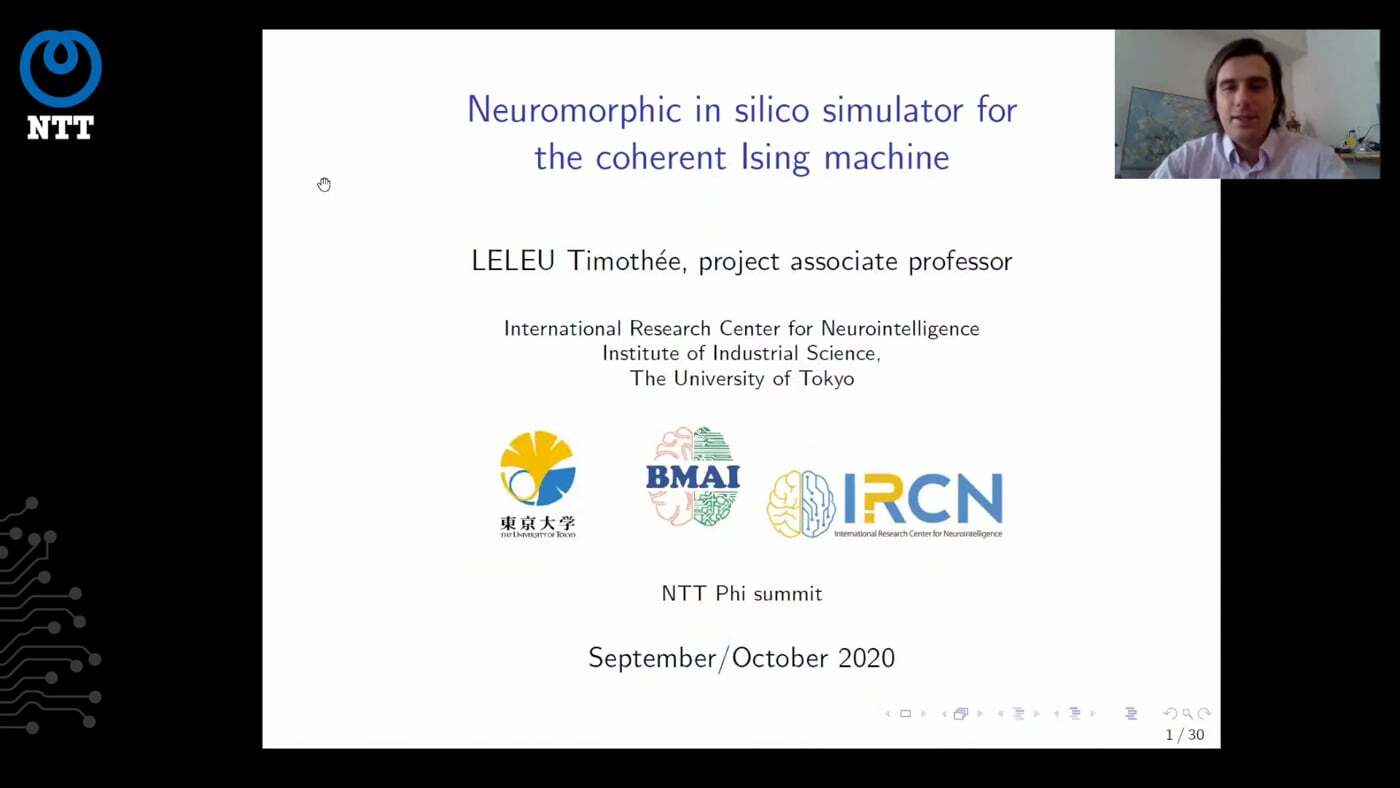PHI Lab Team

Timothee Leleu
Scientist
Timothée Leleu is a Group Head/Senior Research Scientist in NTT Research’s PHI Lab. Prior to joining the company, he worked on neuromorphic computing algorithms and architecture at the University of Tokyo. To date, his most significant contribution to the field of coherent Ising machines is the invention of the chaotic amplitude control (CAC) algorithm. In the PHI Lab, Timothee serves as the head of the Algorithms & Application group.
Videos

Using Principles of Neural Networks to Increase the Efficiency of Ising Machine Simulators
September 21, 2020

A Fast, Scalable, and Reconfigurable Simulation Platform for the Coherent Ising Machine
September 21, 2021
Publications
- Coherent SAT solvers: a tutorial
By Sam Reifenstein, Timothee Leleu, Timothy McKenna, Marc Jankowski, Myoung-Gyun Suh, Edwin Ng, Farad Khoyratee, Zoltan Toroczkai & Yoshihisa Yamamoto
dvances in Optics and Photonics 2023
- Experimental observation of chimera states in spiking neural networks based on degenerate optical parametric oscillators
By Tumi Makinwa, Kensuke Inaba, Takahiro Inagaki, Yasuhiro Yamada, Timothée Leleu, Toshimori Honjo, Takuya Ikuta, Koji Enbutsu, Takeshi Umeki, Ryoichi Kasahara, Kazuyuki Aihara & Hiroki Takesue
Communications Physics 2023
- Mathematical aspects of the Digital Annealer’s simulated annealing algorithm
By Tumi Makinwa, Kensuke Inaba, Takahiro Inagaki, Yasuhiro Yamada, Timothée Leleu, Toshimori Honjo, Takuya Ikuta, Koji Enbutsu, Takeshi Umeki, Ryoichi Kasahara, Kazuyuki Aihara & Hiroki Takesue
Adv. Quantum Technol. 2023
- Collective and Synchronous Dynamics of Photonic Spiking Neurons
By Takahiro Inagaki, Kensuke Inaba, Timothée Leleu, Toshimori Honjo, Takuya Ikuta, Koji Enbutsu, Takeshi Umeki, Ryoichi Kasahara, Kazuyuki Aihara & Hiroki Takesue
Nature Communications 2021
- Scaling advantage of chaotic amplitude control for high-performance combinatorial optimization
By Timothée Leleu, Farad Khoyratee, Timothée Levi, Ryan Hamerly, Takashi Kohno & Kazuyuki Aihara
Communications Physics 2021
- Coherent Ising Machines with Optical Error Correction Circuits
By Sam Reifenstein, Satoshi Kako, Farad Khoyratee, Timothée Leleu & Yoshihisa Yamamoto
Adv. Quantum Technol. 2021
- Coherent Ising machines: Quantum optics and neural network perspectives
By Y. Yamamoto, T. Leleu, S. Ganguli & H. Mabuchi
Applied Physics Letters 2020
- Model-size reduction for reservoir computing by concatenating internal states through time
By Yusuke Sakemi, Kai Morino, Timothée Leleu & Kazuyuki Aihara
Scientific Reports 2020
- Coherent Ising Machines with Error Correction Feedback
By Satoshi Kako, Timothée Leleu, Yoshitaka Inui, Farad Khoyratee, Sam Reifenstein & Yoshihisa Yamamoto
Adv. Quantum Technol. 2020
- A brief state-of-the-art review of Ising machines: algorithms and hardware
By Timothée Leleu
Seisan Kenkyu 2020
Destabilization of Local Minima in Analog Spin Systems by Correction of Amplitude Heterogeneity
By Timothée Leleu, Yoshihisa Yamamoto, Peter L. McMahon & Kazuyuki Aihara1
Physical Review Letters 2019
- Network structure reconstruction using packets of spikes in cultured neuronal networks coupled to microelectrode arrays
By Timothée Leleu, Timothée Levi, Takashi Kohno & Kazuyuki Aihara
Nonlinear Theory and Its Applications, IEICE 2018
- Coherent Ising machines—optical neural networks operating at the quantum limit
By Yoshihisa Yamamoto, Kazuyuki Aihara, Timothée Leleu, Ken-ichi Kawarabayashi, Satoshi Kako, Martin Fejer, Kyo Inoue & Hiroki Takesue
Nature Partner Journal: Quantum Information 2017
- Combinatorial optimization using dynamical phase transitions in driven-dissipative systems
By Timothée Leleu, Yoshihisa Yamamoto, Shoko Utsunomiya & Kazuyuki Aihara
PHYSICAL REVIEW E 2017
- Modulation of context-dependent spatiotemporal patterns within packets of spiking activity
By Miho Itoh & Timothée Leleu
Neural Computation 2017
- Overlapping and non-interfering waves of bursts
By Timothée Leleu & Kazuyuki Aihara
Book Chapter, Cognitive Phase Transitions in the Cerebral Cortex-Enhancing the Neuron Doctrine by Modeling Neural Fields, Springer 2016
- Unambiguous reconstruction of network structure using avalanche dynamics
By Timothée Leleu & Kazuyuki Aihara
PHYSICAL REVIEW E 2015
- Spontaneous slow oscillations and sequential patterns due to short-term plasticity in a model of the cortex
By Timothée Leleu & Kazuyuki Aihara
Neural Computation 2013
- Sequential memory retention by stabilization of cell assemblies
By Timothée Leleu & Kazuyuki Aihara
Book Chapter, Advances in Cognitive
Neurodynamics (III), Springer, 2013
- Combined effects of LTP/LTD and synaptic scaling in formation of discrete and line attractors with persistent activity from non-trivial baseline
By Timothée Leleu & Kazuyuki Aihara
Cognitive Neurodynamics 2012

